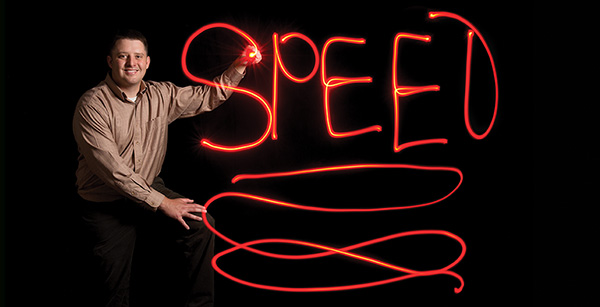
Breaking Speed Records
How can you measure and process data at blistering speeds hundreds of times faster than is possible now? That question drives the research of Mark Foster, assistant professor of electrical and computer engineering at the Whiting School.
For the solution, he says you have to tap into the ultrafast speed of light and the strange behavior of light governed by the branch of optics known as nonlinear optics.
Foster is taking advantage of high-speed lasers to build the fastest imaging system known to date. The system currently snaps images at rates of 100 million frames per second.
“We could do it at even higher speeds,” says Foster, who was recently awarded the National Science Foundation’s prestigious Faculty Early Career Development (CAREER) Award, a five-year $400,000 grant.
Conventional cameras capture images at rates of 1 million frames a second. The camera’s sensors detect sunlight bouncing off every part of the object to recreate the image. Each part of the object or scene is mapped to a pixel of the image.
In Foster’s system, extremely short flashes of light from a femtosecond laser are thrown on the object in a random pattern, illuminating certain parts of it. The object is illuminated multiple times using different patterns. Only about half of the object is illuminated at a time. And every time, sensors measure the light reflected from the object.
“How many samples you take depends on the size and complexity of the image you want,” Foster says. “But you need many fewer measurements than it would take for a pixel-bypixel measurement of the entire object.”
All the measurement data is then fed into a computer. Sophisticated computer algorithms that Foster has developed crunch the data to reconstruct the image. “There is enough information in the measurements generated from the random patterns that the algorithm can figure out what the object is,” he says.
The real breakthrough that leads to the system’s blistering speed is the technique that Foster and his students have developed to generate the random patterns that illuminate the object. Femtosecond laser pulses contain hundreds of different colors of light. Foster’s system gives each pulse a unique color spectrum. Then it spreads out the colors on a two-dimensional space to create the random pattern.
Foster says that the high-rate imaging system could allow lab technicians to screen millions of cells to spot abnormalities that indicate disease.
The high-speed signal processing smarts behind the imaging system could be applied to many different types of data, he points out. The ability to process vast amounts of data would be useful anytime you want to make real-time measurements of things happening at a very fast time scale.
For example, the technique could make cellphone communication more efficient. “Cellphones communicate on microwave frequencies,” he says. “The spectrum available is limited and one thing people like to know is what frequencies are being used and which ones are available.” Foster’s data-processing technique could aid in rapidly scanning the radio frequency spectrum to see which of the millions of frequencies are free for use. The military could also use the technique to analyze radar in real time.




